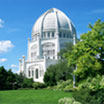Main menu
- ‘Abdu’l-Bahá’s Journey
- World Peace
- Stopping Racism in America
- Empowerment of Women
- More Principles...
- Prayer for America
Helen Goodall

Helen Goodall became one of the earliest American Bahá’ís in 1898. Her daughter Ella Cooper learned of the Bahá’í Faith from a friend of Phoebe Hearst and told her mother about it. Residents of the San Francisco Bay area, both women traveled to New York to learn more about the Faith from Anton Haddad, one of the first Bahá’í teachers sent to America by ‘Abdu’l-Bahá.
Mother and daughter went on Pilgrimage to the Holy Land in 1908. Of these early Pilgrimages, Shoghi Effendi wrote
The photograph of Mrs. Goodall above was taken in the Holy Land, in the garden adjoining the House of ‘Abdu’l-Bahá in Haifa. Upon her return to America, Mrs. Goodall and her daughter published a small book recounting their experiences, “Daily Lessons Received at Acca”.“I can never hope to interpret adequately the feelings that surged within those heroic hearts as they sat at their Master’s feet, beneath the shelter of His prison-house, eager to absorb and intent to preserve the effusions of His divine Wisdom. I can never pay sufficient tribute to that spirit of unyielding determination which the impact of a magnetic personality and the spell of a mighty utterance kindled in the entire company of these returning pilgrims, these consecrated heralds of the Covenant of God, at so decisive an epoch of their history. The memory of such names as Lua, Chase, MacNutt, Dealy, Goodall, Dodge, Farmer and Brittingham — to mention only a few of that immortal galaxy now gathered to the glory of Bahá’u’lláh — will for ever remain associated with the rise and establishment of His Faith in the American continent, and will continue to shed on its annals a lustre that time can never dim.”
(Shoghi Effendi, The World Order of Bahá’u’lláh, p. 81)
Mrs. Goodall’s home in Oakland, California became an important center for the promotion of the Bahá’í Faith on the West Coast of the United States. Thornton Chase, the first American Bahá’í, often traveled by train from Los Angeles to Mrs. Goodall’s home on weekends to give Bahá’í firesides.
In 1912, ‘Abdu’l-Bahá invited Mrs. Goodall to spent a good deal of time with Him during His stay in Northern California:
When ‘Abdu’l-Bahá sent the Tablets of the Divine Plan to the United States and Canada, each Tablet to the American Bahá’ís was addressed to a different region; the Tablet to the Western States was revealed in honor of Helen Goodall. Her rank in the Bahá’í community is also shown by the fact that she was a recipient of one of the last telegrams ‘Abdu’l-Bahá sent for the guidance of the American Bahá’í community, just ten days before His passing. (The Priceless Pearl, p. 49)“When He was in California, ‘Abdu’l-Bahá showed Helen Goodall extraordinary kindness. He asked her to come to His house every morning as early as possible and to remain all day. He repeatedly praised her pioneering eforts and called her the spiritual mother of the first Spiritual Assembly in the area. When He left, He told her, ‘I leave my sheep in your care.’”
(Earl Redman, “‘Abdu’l-Bahá in Their Midst,” p. 212)
Helen Goodall was named one of the nineteen “Disciples of ‘Abdu’l-Bahá” by Shoghi Effendi, the Guardian of the Bahá’í Faith. He also mentions her prominently in his history of the first century of the rise and development of the Bahá’í Faith:
“The stout-hearted Thornton Chase, surnamed Thabit (Steadfast) by ‘Abdu’l-Bahá and designated by Him ‘the first American believer,’ who became a convert to the Faith in 1894, the immortal Louisa A. Moore, the mother teacher of the West, surnamed Liva (Banner) by ‘Abdu’l-Bahá… and Helen S. Goodall, whose names will ever remain associated with the first stirrings of the Faith of Bahá’u’lláh in the North American continent, stand out as the most prominent among those who, in those early years, awakened to the call of the New Day, and consecrated their lives to the service of the newly proclaimed Covenant.”
(Shoghi Effendi, God Passes By, p. 257)
(Additional Ref: Whitehead, “Some Early Bahá’ís of the West,” pp.21-34 and “Mahmud’s Diary”, p. 440)










